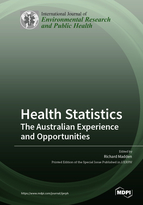Health Statistics: The Australian Experience and Opportunities
A special issue of International Journal of Environmental Research and Public Health (ISSN 1660-4601). This special issue belongs to the section "Public Health Statistics and Risk Assessment".
Deadline for manuscript submissions: closed (15 December 2021) | Viewed by 44316
Special Issue Editor
Special Issue Information
Dear Colleagues,
Reliable and relevant health statistics have provided a strong base for policy, planning and financing of health and related services in Australia. States and Territories are responsible for public health, hospitals and many other health and related services, and building national statistics has required cooperation and clear governance as well as strong national data standards. Australia has for more than a century had excellent mortality statistics; more recently a wide range of other data has been developed from administrative sources, where statistics is often a secondary purpose, and registers. Statisticians have had to negotiate to get the information needed, and the data standards to be used, with a wide range of governments and service providers, as well as user and advocacy groups. Statistics on specific groups, notably Aboriginal and Torres Strait Islander peoples, have required collaboration with the communities involved, as well as presenting technical challenges. More complex analyses have , with health expenditure and burden of disease as examples of methodologies where summary statistics must be built on a strong statistical foundation.
While these developments have been underway, electronic systems have progressively been replacing paper, and data are required more quickly and at more local levels. Data linkage is now widely accepted as a means of providing linked information to statisticians and researchers without risking the privacy and confidentiality of individuals. A wide range of the health workforce is involved in data collection, and they may be subject to a range of service delivery and financial pressures which can limit or influence the data they collect.
This special issue aims to report on current Australian health statistics collections, their uses and the challenges they face. It is vital to understand the processes that have led to success, and the hurdles that have had to be overcome. We also want to identify remaining gaps, in subject matter, in populations with specific needs and in data standards, in data accessibility and where Australia may lag behind developments in other countries. Other topics could include governance issues, where the range of conflicting pressures on data providers, analysers and users may endanger reliability. The issue will provide a platform for a wealth of views to be brought together and connected, to give a rare broad view of the health statistics terrain in Australia.
Prof. Dr. Richard Madden
Guest Editor
Manuscript Submission Information
Manuscripts should be submitted online at www.mdpi.com by registering and logging in to this website. Once you are registered, click here to go to the submission form. Manuscripts can be submitted until the deadline. All submissions that pass pre-check are peer-reviewed. Accepted papers will be published continuously in the journal (as soon as accepted) and will be listed together on the special issue website. Research articles, review articles as well as short communications are invited. For planned papers, a title and short abstract (about 100 words) can be sent to the Editorial Office for announcement on this website.
Submitted manuscripts should not have been published previously, nor be under consideration for publication elsewhere (except conference proceedings papers). All manuscripts are thoroughly refereed through a single-blind peer-review process. A guide for authors and other relevant information for submission of manuscripts is available on the Instructions for Authors page. International Journal of Environmental Research and Public Health is an international peer-reviewed open access monthly journal published by MDPI.
Please visit the Instructions for Authors page before submitting a manuscript. The Article Processing Charge (APC) for publication in this open access journal is 2500 CHF (Swiss Francs). Submitted papers should be well formatted and use good English. Authors may use MDPI's English editing service prior to publication or during author revisions.
Keywords
- Aboriginal and Torres Strait Islander peoples and their health
- Specific topics such as primary care, hospital statistics, functioning and disability, mental health, aged care, monitoring of population health
- Health risk behaviours and environmental risk factors
- Information developments associated with COVID-19
- Current opportunities and trends including data linkage and electronic data
- The contributions that health statistics make to research
- Analyses of health statistics including health expenditure and burden of disease
- Health information workforce
- Health statistics governance, particularly at national level, and health ethics.






